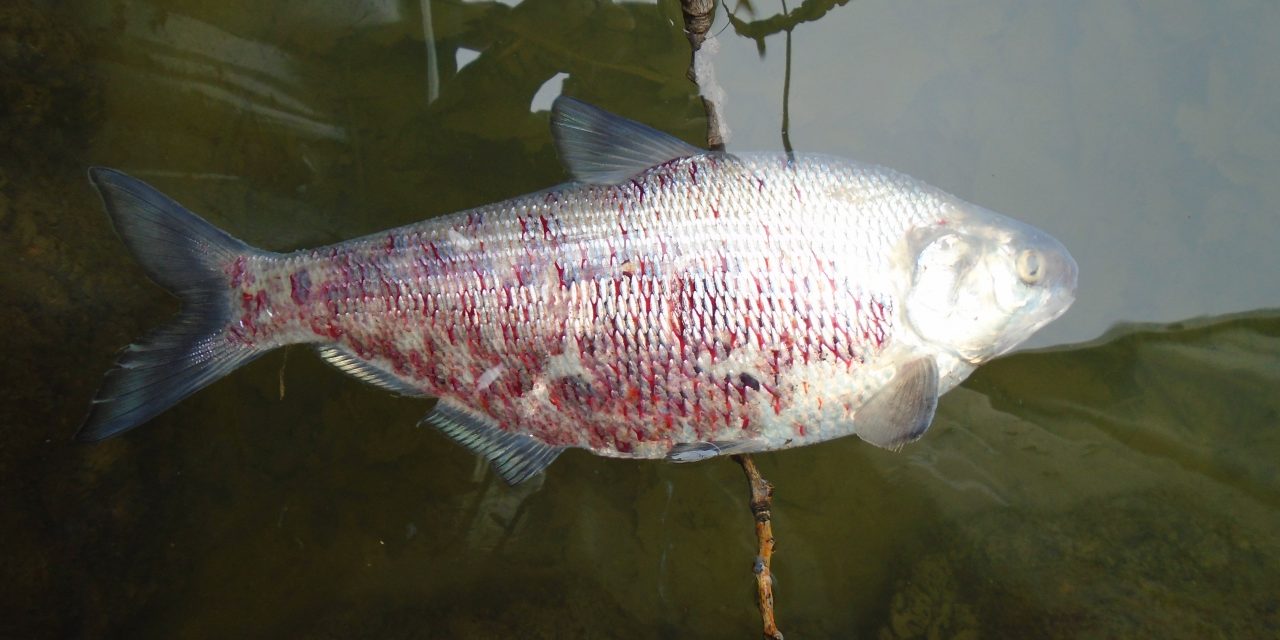The state Department of Natural Resources is blaming the die-off of thousands of fish in Lake St. Clair on a highly infectious virus, but the environmental group Save Lake St. Clair remains concerned that pollution played a role.
The dead fish populating the shoreline, particularly in the Anchor Bay area, are victims of viral hemorrhagic septicemia virus, or VHSv, according to the DNR. While deadly to several fish species, the virus poses no risk to humans, even if they consume infected fish, DNR officials said. The species most affected appears to be the gizzard shad (pictured above).
The dead fish began showing up at the shoreline earlier this month. A similar big fish kill on Lake St. Clair in 2006 sparked concerns that pollutants from sewage system overflows.
In a statement, Mike Gutow, founder of Save Lake St. Clair, said he is suspicious that the state has not explored all aspects of the situation:
“DNR is stating large fish (die-off) in Lake St. Clair is most likely from VHS, a nasty virus that affects about 30 species of fish. Good news is this apparently is not harmful to humans. … However, what is also concerning is in this report is mentioning the … fish die-off that also occurred in 2006, and we mentioned before and shown our own footage from the fish die off in 2011 we experienced. We find it a little odd that when you also look at the corresponding sewage overflow from 2006 and 2011 they are also very similar to this year…just saying.”
Here is the press release issued by the DNR:
The Michigan Department of Natural Resources is investigating several fish mortalities – particularly of gizzard shad – that have been reported by citizens around Lake St. Clair. A number of samples have been collected to determine the cause. Some of the fish may have been affected by viral hemorrhagic septicemia virus (VHSv), a very contagious pathogen, but the DNR is still waiting on confirmation.
“Thanks to the public’s vigilance we are able to get timely samples from these fish mortalities, and it is very likely VHSv is involved,” said Gary Whelan, research program manager for the DNR’s Fisheries Division. “VHSv has been detected in these waters since at least 2003, and when conditions are right the pathogen will cause disease events like this one.”
Many of the collected fish showed the classic external signs of VHSv: bloody patches on the skin. VHSv first caused fish mortalities in the St. Clair-Detroit River corridor in 2006 and occasionally has been detected in these waters since that time.
The virus is known to infect more than 30 species of Great Lakes fish and has been found in lakes Superior, Huron, Erie and Ontario, along with a few inland lakes. Some species such as lake sturgeon and walleye are very resistant to it and others such as bluegill, largemouth bass, muskellunge, gizzard shad and round goby are very susceptible to the virus. The pathogen causes the fish’s blood vessels to leak, which is why the skin shows bloody patches. This symptom is shared with other pathogens, so testing is needed to confirm if VHSv is involved. Previous research has shown that many fish recover from this virus infection, although there is no treatment.
“The public is encouraged to continue to provide us with reports of fish kills with a focus on kills of more than 25 fish,” Whelan said. “The public can provide the reports to our fish kill email address at DNR-FISH-Report-Fish-Kills@michigan.gov. This information helps us track this event and determine where best to collect additional samples.”
Anglers are reminded to refrain from moving live fish between water bodies and to properly dispose of bait. Boaters need to make sure their bilges and live wells are emptied prior to leaving a boat launch, and equipment must be cleaned and disinfected after use. Visit michigan.gov/fishing for more information on how those who fish and boat can help limit the spread of fish disease and invasive species.





I would like to use the chance of thanking you for your professional guidance I have enjoyed visiting your site.
I’m looking forward to the commencement of my school research and
the complete planning would never have been complete without consulting
your web blog. If I could be of any assistance to others,
I might be happy to help as a result of what I have learned from here.